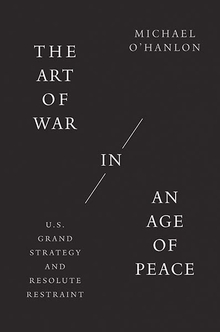Michael E. O’Hanlon warns that “today, the possibility exists that Washington could be forced to choose between risking war and appeasing Chinese or Russian aggression in ways that ultimately could lead to much graver threats. This is a Catch-22 we need to avoid.” This piece first appeared in The Hill.
Defense Secretary Lloyd Austin is advocating an approach to national security that he calls integrated deterrence. It is designed to employ the full range of American capabilities, used either punitively or preventively, to persuade potential aggressors not to attack the United States or its core overseas interests.
Having argued for a similar concept — which I call indirect or asymmetric defense in a new book, “The Art of War in an Age of Peace: U.S. Grand Strategy and Resolute Restraint” (with equal emphasis on resoluteness and restraint) — I agree with Secretary Austin. The framework he advocates merits greater discussion and elucidation — and, most of all, action, especially in the non-military realms of national security policy.
Part of why the concept of integrated deterrence — including economic instruments of multiple types, as well as cyber, informational and diplomatic capabilities — is so important is this: A classic military invasion or large-scale attack by Russia or China seems far less likely than smaller, more limited and possibly “gray-area” aggression. We need credible responses where the punishment fits the crime, rather than imagining that the world’s greatest military would come quickly to the rescue by, for example, sinking China’s 350-ship navy in the opening days of battle over islands in the western Pacific, as some have implied we might do. And we need to worry about actions that might fall short of direct assaults on American treaty allies, such as a Chinese attack on Taiwan or an expanded Russian attack on Ukraine, that nonetheless would be unconscionable and impossible to ignore.
Indeed, today, the possibility exists that Washington could be forced to choose between risking war and appeasing Chinese or Russian aggression in ways that ultimately could lead to much graver threats. This is a Catch-22 we need to avoid.
In the event of limited enemy aggression — say, the seizure of a contested island in the Baltic Sea or western Pacific, perhaps a partial Chinese blockade of Taiwan to squeeze the island into strategic submission — a large-scale U.S. and allied response could seem massively disproportionate. Yet a non-response would be unthinkable and potentially inconsistent with American treaty obligations and other commitments. Washington could be faced with two equally senseless, unacceptable options.
Integrated deterrence and asymmetric defense offer alternatives. Without renouncing the possibility of a direct response to liberate allied territory, they could meet China or Russia at whatever level of escalation Beijing or Moscow wanted to consider in a proportionate (though not necessarily identical or symmetric) fashion. This strategy would combine military elements with economic warfare.
The military components could feature redeployments during and after a crisis, strengthened forward defenses, and perhaps limited military attacks against Russian or Chinese assets, quite possibly in other theaters from where the initial attack occurred.
The instruments of economic warfare could include offensive elements, notably various types of sanctions that might evolve and expand with time during a crisis and perhaps beyond. The sanctions could feature targeted penalties against individuals, or more sweeping restrictions against whole sectors of an adversary’s economy, and should be applied in conjunction with as many U.S. allies as possible. Such economic instruments would have to include defensive measures to ensure the resilience of the United States and its allies against possible enemy reprisal.
Thus, we must prepare the strategy now, to make it credible and effective at deterring (rather than simply punishing, after the fact) an unacceptable threat to the global order.
The state of technology, and expected trends in future innovation, compound the problem of relying on military capabilities to deter or reverse the kinds of limited yet potentially quite consequential challenges to the global order that Secretary Austin and others rightly have on their minds. Deployment of large U.S.-led military forces into the lion’s den of the western Pacific near China’s coasts, or into the Baltic regions of Europe near Russia, is becoming a harder and harder proposition to entertain. The spread of the type of precision technology that the United States once effectively monopolized accounts for much of the reason why.
The problem is exacerbated by other technological realities or near-term weapons possibilities, such as miniaturized robotics that function as sensors or even weapons, individually or in swarms; small satellites that could function as clandestine space mines against larger satellites; homing anti-ship missiles, and various types of superfast hypersonic missiles in general; and threats to computer systems from both traditional human-generated hacking and artificial intelligence-generated algorithms.
On balance, it probably will become increasingly difficult to project large military forces near another great power’s territory. This is not quite the same thing as arguing that the “offensive-defensive balance” will tilt in favor of defense at all times and under all conditions, or even that there is a single offensive-defensive balance of general validity. But a plethora of relatively small, fast, precise, inexpensive, autonomous weapons could threaten large exposed objects such as ships, planes, ports and rail lines — to say nothing of other fixed infrastructure, such as fiber-optic cables, electricity generation and transmission lines, bridges and tunnels, and other infrastructure of crucial importance to modern militaries on the move.
Washington needs better, less escalatory, and thus more credible options for such limited but serious scenarios. They should not formally displace existing policy, under which there is a strong implication of prompt U.S.-led military action to liberate any allied territory that might be attacked or seized by an aggressor. This current policy may have deterrence benefits, as well as reassurance benefits for allies, so it should not be formally scrapped. But it may not be fully credible, even with an American president less inclined to question publicly the wisdom of U.S. alliances than was President Donald Trump. Would an American president really trade Seattle for the uninhabited Senkakus?
Current options and war plans also may not give U.S. and allied policymakers sufficiently flexible and smart options in the event of deterrence failure. Instead, the new paradigm I propose here is intended to complement existing concepts and plans. Rather than supplant existing concepts for deterrence and warfighting, it seeks both to repair weaknesses in their credibility and to avoid unnecessary dangers that could result from their prompt implementation. Under the new paradigm, the United States and its allies would not be obliged to fire the first shot, or to quickly escalate after a hypothetical Russian or Chinese aggression. They would have indirect and asymmetric options.
By adopting a more complex, multidimensional approach to national security policy that made fuller use of economic instruments of national power, Washington would in a sense just be catching up with Beijing and Moscow. Russia has used economic punishment tactics against Ukraine in the energy and banking sectors, employed cyberattacks against a number of NATO countries, and interfered in Western elections through various methods of information warfare. China has used economic coercion against a number of its neighbors; it banned shipments of rare earth metals to Japan for a time in 2010, froze imports of Norwegian salmon after the Chinese dissident Liu Xiaobo won the Nobel Peace Prize that same year, restricted imports and tourists from the Philippines over a dispute over the Scarborough Shoal in the South China Sea in 2012, and punished South Korea economically after the deployment of a U.S. THAAD (Terminal High Altitude Aerial Defense) missile defense system to the latter in 2016-17. It has also stolen intellectual property from more advanced nations, not only to enhance its own economy but to close the military-technological gap with the West. These countries realize that economics is often at the heart of security strategies.
The United States itself has understood this same fact very well in the past, such as during the Cold War. Thus Secretary Austin, and those of us who agree with him, are not proposing a radically new theory so much as suggesting we dust off, enhance, and expand old ideas for modern times.
The Brookings Institution is committed to quality, independence, and impact.
We are supported by a diverse array of funders. In line with our values and policies, each Brookings publication represents the sole views of its author(s).










Commentary
The best defense? An alternative to all-out war or nothing
May 21, 2021